|
2015 Airshows
Titusville (Tico), FL
Virginia Beach, VA
Seymour Johnson AFB, NC
Halls, TN
Warsaw, IN
B-29 Air Power Tour Fort Wayne, IN
Thunder over Michigan, Bellevue MI
Thunder over Michigan Warbird
Photo Review
Warbirds at the Willow Run, MI Airshow 2015 -
August 29-30, 2015 (Photos taken 8-29-2015.)
Every year the Thunder over Michigan Airshow
brings to the Midwest an outstanding and varied group of warbirds and
2015 gave us a totally different venue than past events, with two sets
of aircraft that flew in the event; fighters and bombers.
For the fighter group there were P-51s,
Corsair, Fw-190, and Spitfire. The bombers were really the
featured group with Mosquito, Lancaster, B-25s, B-17, B-29, PV-2, PB4Y,
and A-26. As in the past, there were ample low fly-bys of both
groups to make any warbird enthusiast go home with a smile on his/her
face and fond
memories of the event. The following are some of the highlights
of the show, and are not inclusive of all aircraft on the ramp or flying
in the show, as I have attempted to pick out a few that give a flavor of
the event. As in 2014, I have added information on how the
American automobile industry contributed the the building of many of the warbirds at the show, not just the contribution of Ford building B-24s
on the west side of the field during WWII, or Packard's building of
Rolls-Royce Merlins in downtown Detroit, which are both emphasized by
the narrator to the exclusion of all others.
In 2014 the Yankee Air Museum was able to
purchase a portion of the former and historical Ford B-24 plant on the
west side of the Willow Run airport that will be turned to a large
aviation education museum. At the airshow for the past couple of
years the narrators have spent time each day talking about the saving of
this portion of the plant, and its historical role in the defense of the
United States during the Second World War. Below are several
photos of the plant that produced 8,684 B-24 Liberators.
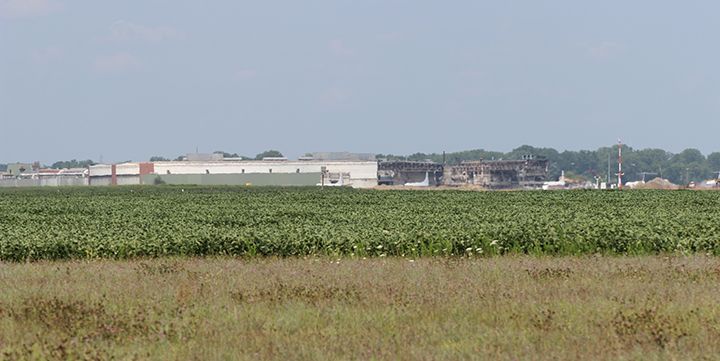
This photo was taken in 2014 at the show,
which shows the open steel structure to the north of the museum area as
the plant was being razed.
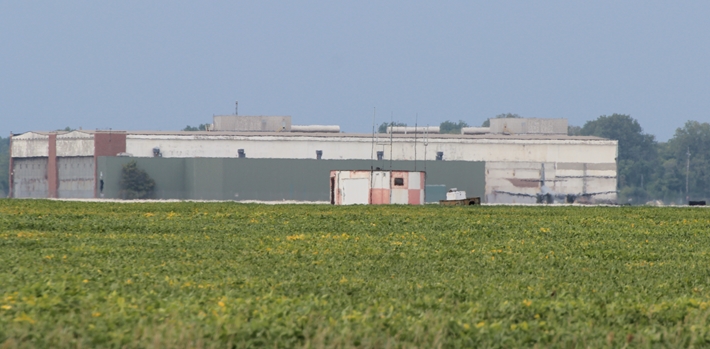
This photo was taken looking at the same
location but this year only the museum section is all that remains. This is all that
remains of one of the largest manufacturing plants of WWII. (There
are several plants across the country that claim this honor.)
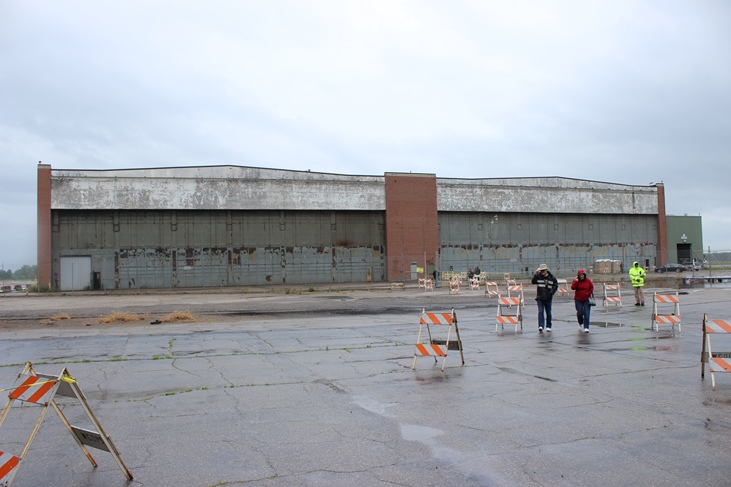
On June 27th of this year the Yankee Air
Force held an open house for those interested to come out and see the
remains of the plant in its unaltered form, before coming a museum.
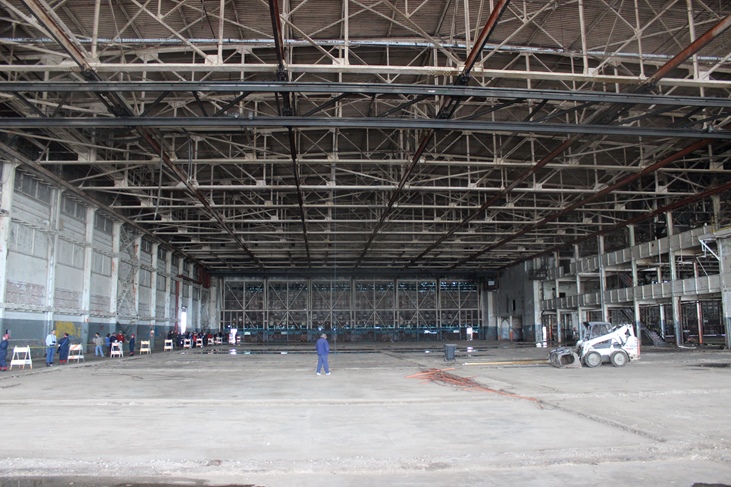
Looking south from the north end of the
building. One of the Rosie the Riveter tour guides told me the
doors had been designed to be large enough for the B-29. This is
only one of two bays, with a similar one to the right, or west of this
one.
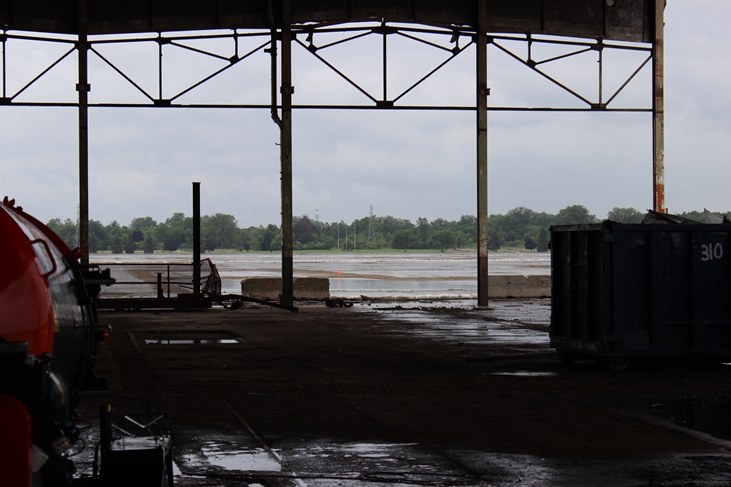
This photo was taken at same location as the
last except one is looking west at the concrete floor of the former plant that runs
all the way out to the flag poles in the distance 3,200 feet away.
On June 27th there were no walls on the west or north side of the
structure, but since then the walls have started to go up to fully
enclose the building for the new museum.
The show narrators are correct on historical
aspect of the former bomber plant, and at the same time the Yankee Air
Force must be commended for the excellent job it has done to raise to
date $6 million dollars to purchase the building and start the
restoration, which will cost another $10 million to complete. But,
as was noted last year by this author in the 2014, the Ford Bomber Plant
has unfortunately over shadowed the larger contribution the entire
US automobile industry made to the winning of WWII.
The total dollar value of the B-24s that came
off the Willow Run assembly line had a value of $1.14 billion out of $29
billion that the entire US auto industry produced for the winning of the
war, or 4% of the total. Not insignificant for one plant and one
product, but there is still the remaining 96% or $28 billion that gets forgotten.
During WWII General Motors produced $12 billion in war
contracts, Ford Motor Company came in a far second with $3.9 billion in
war output, and Chrysler was not far behind in producing $3.5 billion in
defense products. The only other dollar value my research has
found is that Willys-Overland in Toledo, OH produced $730 million in
nineteen wartime projects, doing a lot more than making Jeeps. A
good percentage of what the American auto industry produced was for the
aviation industry, and many examples of its contribution in making US
warplanes was on the ramp at the 2015 Thunder over Michigan Airshow.
As in 2014, I will as usual report on the aircraft and the show itself,
with added commentary on the contribution of the American auto industry
to specific aircraft.
The Ramp.
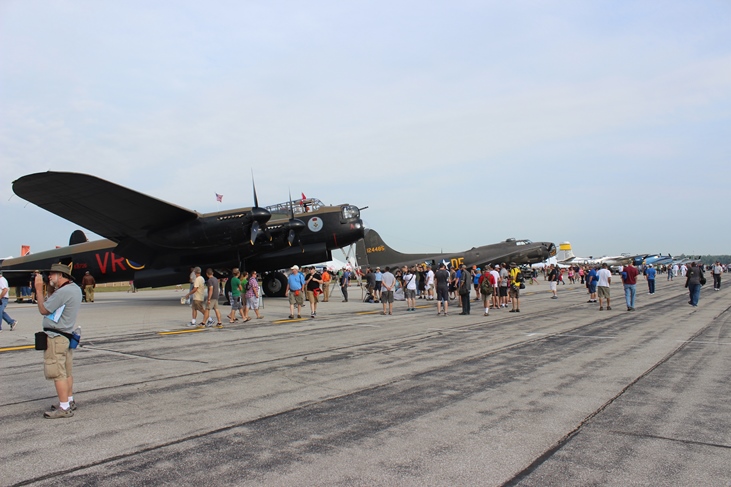
This year the airshow staff at Thunder focused on bombers, not any
specific one as in years past, but a collection of individual types.
Here we find the Avro Lancaster, B-17 "Memphis Belle", A-26B and the
PV-2 Harpoon "Attu Warrior".
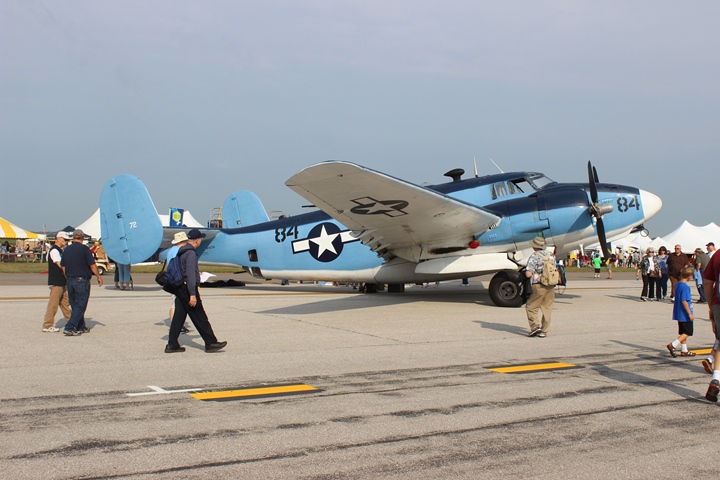
This rare PV-2 Harpoon is one of only two
currently flying, and if I am not mistaken, this is its first appearance
at Thunder. Hopefully it is not the last as it is such a great
looking aircraft.
US Auto Industry Contribution: Ford R-2800 engines and
Chrysler built cockpit enclosures.
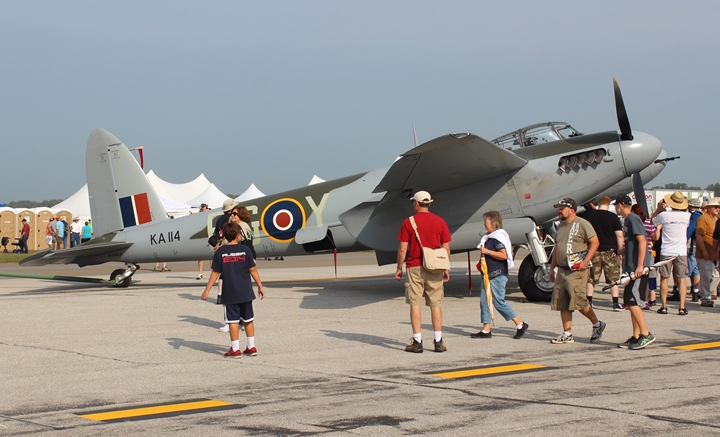
Many came just to see this de Havilland
Mosquito on display and fly during the show.
US Auto Industry Contribution: Being of British design and
this particular one Canadian built, one would not think the American
auto industry would not have anything in it. Not so! All of
the two piece formed wood fuselages were built by GM of Canada. At
first glance this would seem odd, until one is reminded it wasn't until
ten years before the start of WWII that automobile bodies were still
being made out of wood, and there was still a lot of experience within
the industry of working with it. Packard supplied the engines and
Nash-Kelvinator in Lansing, MI furnished the propellers. It was
the first propeller contract the Lansing plant received and my grandfather was a foreman
in blade balancing department.
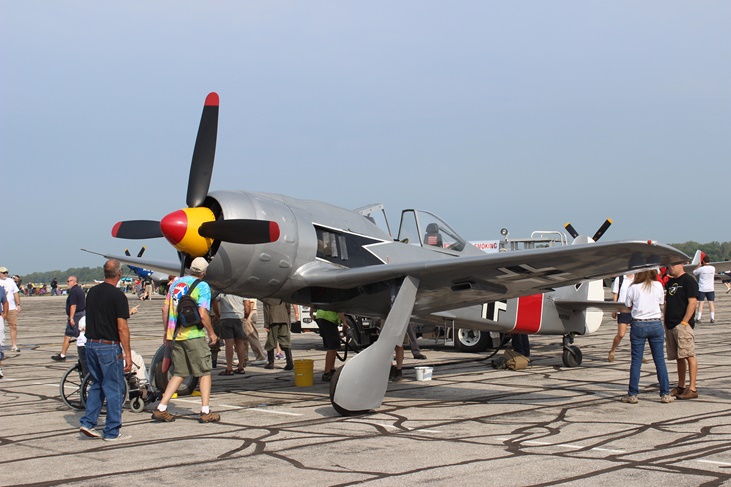
Another rare aircraft many of us came out to see, was this Focke-Wulf
Fw-190A-8.
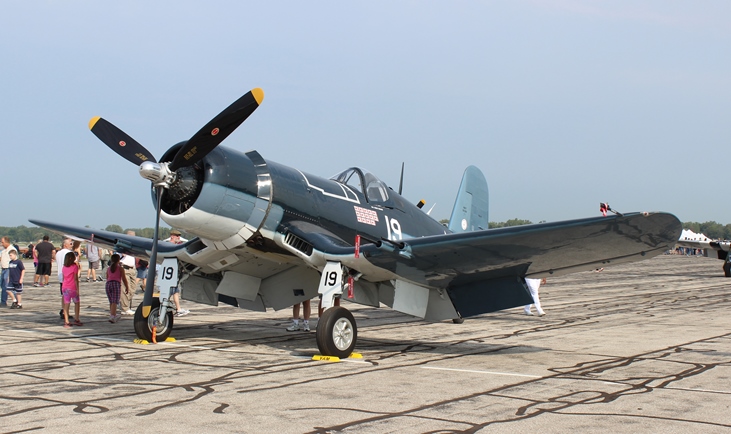
Goodyear, one of the three major tire suppliers to the auto industry
when WWII started, was one of four auto companies that produced aircraft
during the conflict. This FG-1D is one of 4,007 FG series Corsairs
produced by the company, which also produced all of the airships for the
Navy, along with building major portions of the B-29.
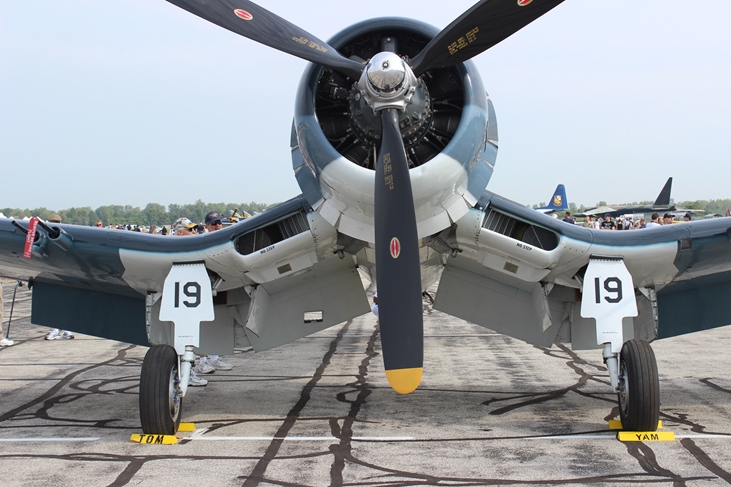
This photo shows three products produced by the auto companies.
Nash-Kelvinator in Kenosha, WI built R-2800 engines for the Corsair and
Chrysler built over 10,000 landing gear for the aircraft. The
difficult to build due to its gull wing configuration wing center
section was built by Willys-Overland, which when the war ended had
produced 3,371 of them.
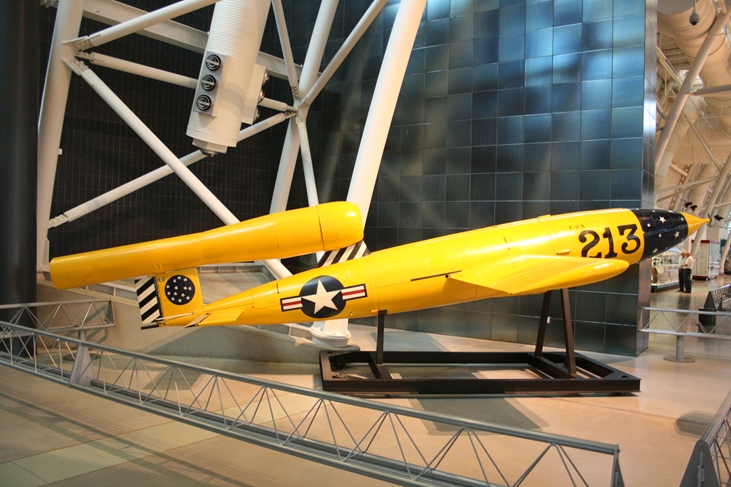
Speaking of Willys-Overland, unfortunately one its most important
products that has been overlooked and just plain forgotten by historians
is that the company made all of the 1,292 airframes for America's first
cruise missile, the JB-2. Also lost in the hype over the Willow
Run Bomber plant is the fact that Ford Motor Company built all 1,292 of
the pulse jet engines. Reversed engineered from the German V-1,
the JB-2 would have been used in the planned invasion of Japan.
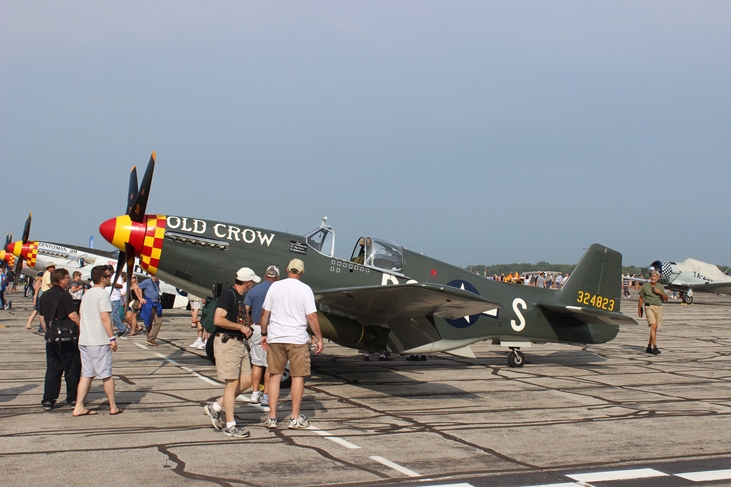
P-51B "Old Crow" was one of three Mustangs
that participated in the show.
US Auto Industry Contribution:
Most warbird enthusiasts are well aware that
the Mustang became the fighter it was when powered by the Packard built
Rolls-Royce V-1650 Merlin engine, built on East Grand Boulevard in
downtown Detroit. But they may not be aware that Buick cast the
cylinder blocks or that Graham-Paige machined parts for the engine.
They may also not be aware that Henry Ford was originally approached to
build the engine and refused, as he did not want to work with a foreign
company and country. But Ford did go on to build 57,851 R-2800 engines
at the River Rouge, which was several thousand more engines than Packard
built of the Merlins. Chrysler also refused the work on the Merlin but
that was because it did not want to commit the engineering resources to
converting British drawings and specifications to American ones.
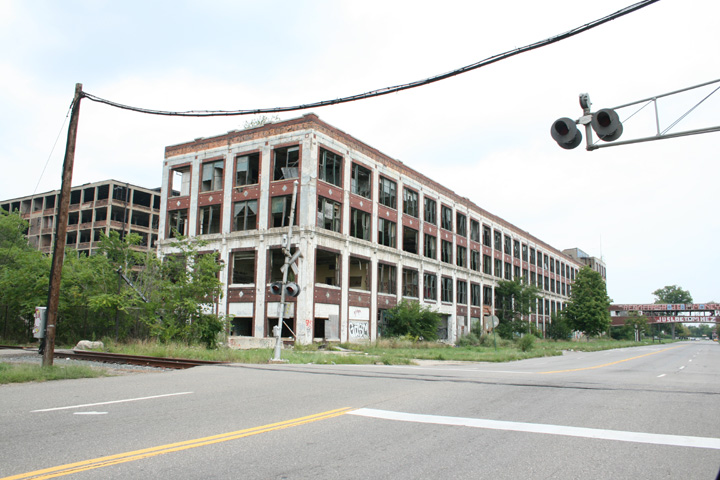
With the demolition of most of the Willow
Run Plant, the former Packard plant in downtown Detroit now has more
still standing of it than what Willow Run has. Actually this
complex of buildings has had more photographs taken of it and more
newspaper/magazine/websites dedicated to it than the Willow Run Plant
could even dream of, as it had become the historic icon of what Detroit
used to be in its prime. The plant was finally purchased from the
City of Detroit in the past year or so by a private investor who is now
working to restore the buildings and lease out the floor space.
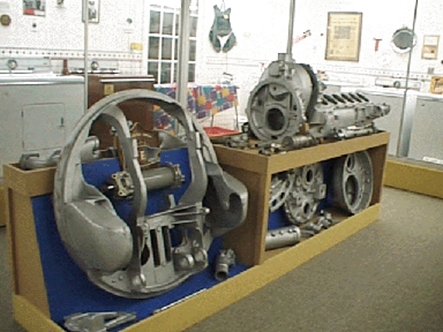
And then during the show announcer Rob Reider was talking about P-51s,
Merlin engines, and Packard when he all of sudden mentioned he had seen
engines in Mustangs with the name "Maytag" on them. I have worked
with Rob at shows as a co-narrator and also listened to him at many
more, and this was the first time I had ever heard him say anything
about "Maytag Merlins". And I was a little confused with Packard
being the only producer in North America of the engine. A little
research has revealed that Maytag actually cast engine blocks and
several other castings for the engine as seen in this photo. The
company cast the name Maytag into each part it made which is why one can
find the that name on a Packard built Merlin. It also looks like
it made casings for the Martin turret.
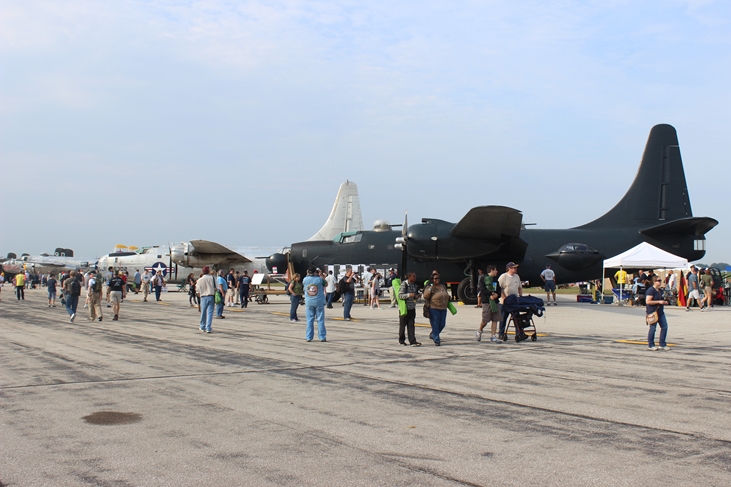
This group of bombers included two PB4Ys and B-25s. The blue
Privateer has been on outside static display at the Yankee Air Museum
location for many years and the group is now in the process of
restoring the aircraft. One PB4Y at an airshow is extremely rare,
two together is a great job by the show!!
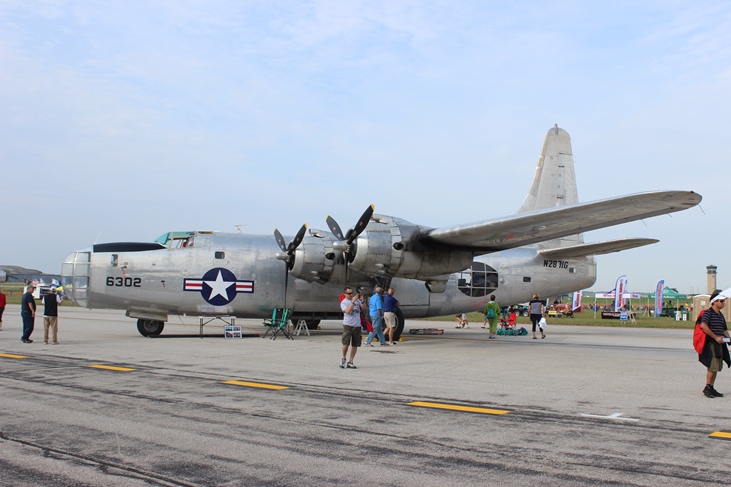
This is the only Privateer currently flying and this is only the second
time I have seen the aircraft on display and then fly, although that was only for a take-off at Chino in 2013.
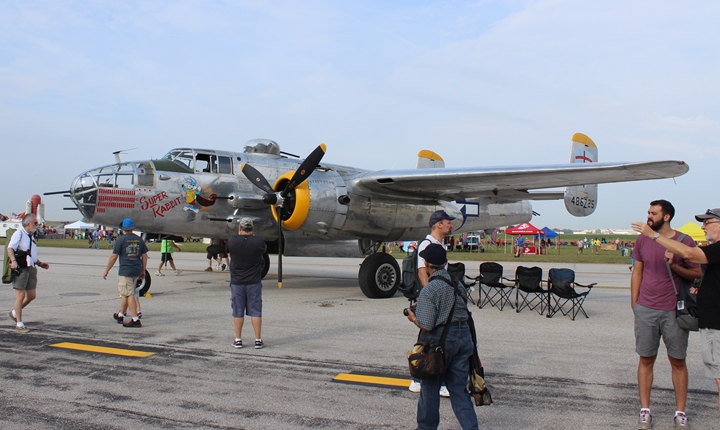
This is the first time I have seen this
newly restored B-25J owned by the Oklahoma Museum of Flying. Built
a the Fairfax, KS North American plant it has served with the USAAF,
RCAF and the Venezuelan Air Force, was a Gate Guard in Bolivia and
suffered a forced landing in a swamp at Titusville, FL in 1987 after
returning to the US in 1984. It has had a myriad of owners since
then and has now been restored again by the Museum over the past three
years. It is good to see another B-25 back out on the airshow
circuit!
US Auto Industry Contribution:
When the Fairfax plant opened up the Fisher
Body Davison of GM supplied 55% of the content that went into the B-25s
built there which included wings, fuselages, tail assemblies, exhaust
collectors along with forgings, castings and machined parts. Fisher
Body supplied Fairfax from its opening in 1941 through June of 1945.
Ten Fisher Body plants were involved in this endeavor. One of the
Fisher Body plants was also in Lansing, MI, where my mother worked
during the war.
The Morning Battle.
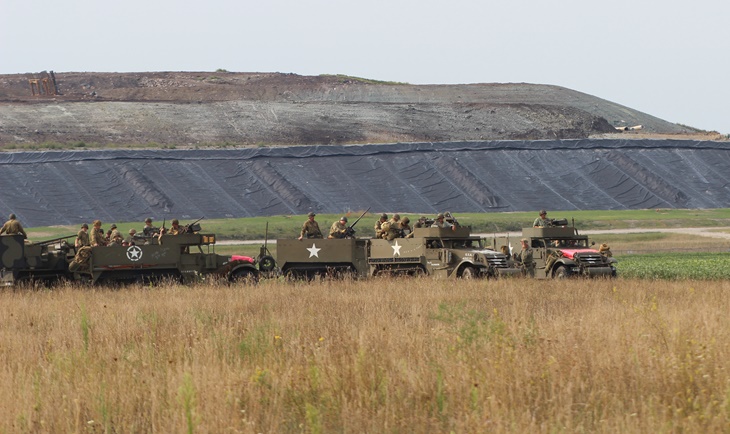
Each year there is a morning and afternoon re-enactor battle. This
year the battle on the ground featured fourteen WWII built half-tracks,
representing Autocar, White and Diamond T.
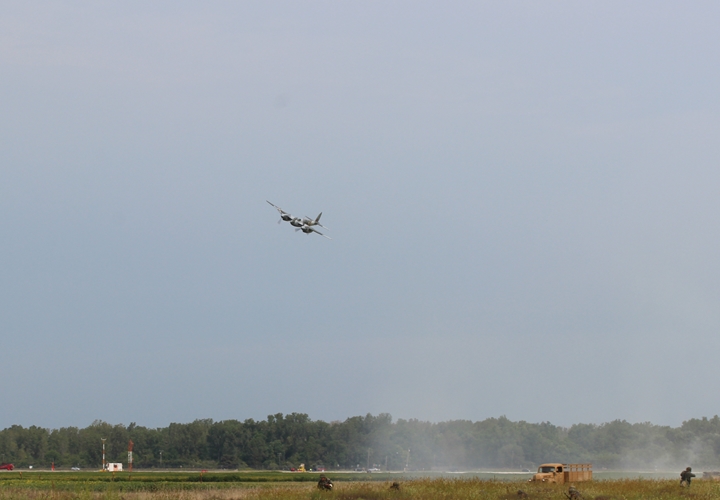
And each year aircraft fly cover for the soldiers on the ground.
During the morning's event the Mosquito and the Spitfire flew top cover.
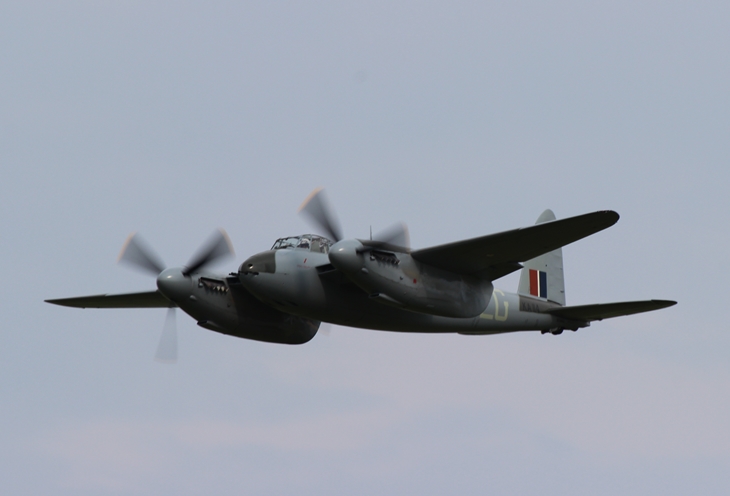
Of the three events I have seen the Mosquito fly at, the best and lowest fly-bys were here at Thunder.
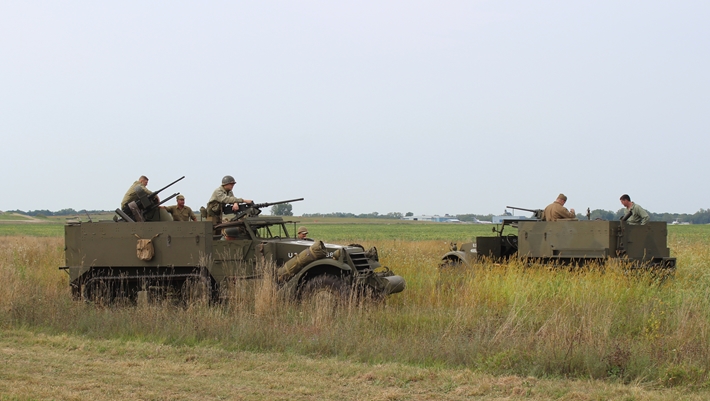
On the right is a White M4A1 81mm mortar carrier and an M16 .50 quad
mount on the left.
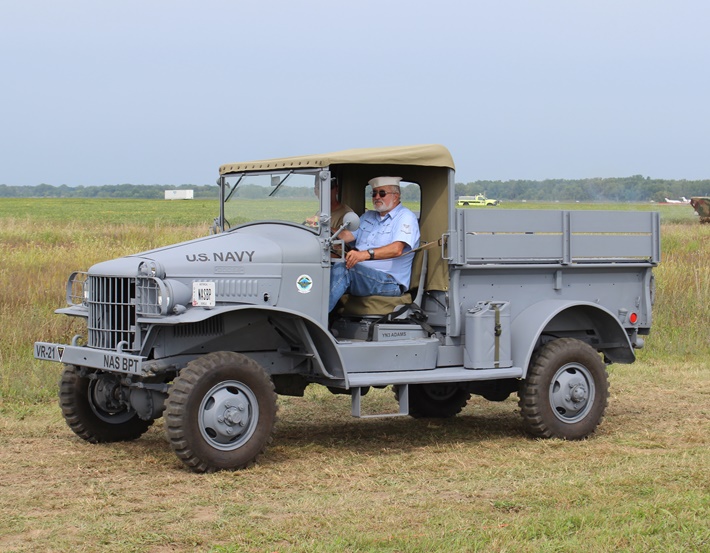
While not part of the battle, this Dodge WC21
half ton truck was part of the pass in review after the battle and
represents the 404,817 trucks Dodge built during the Second World War,
and the over million trucks built in total by the US auto industry for
the war effort.
The Airshow.
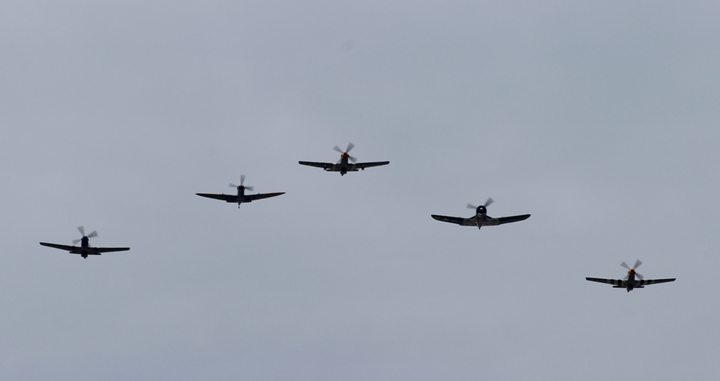
The show opened with an over the head pass by three P-51s, FG-1D and the
Spitfire.
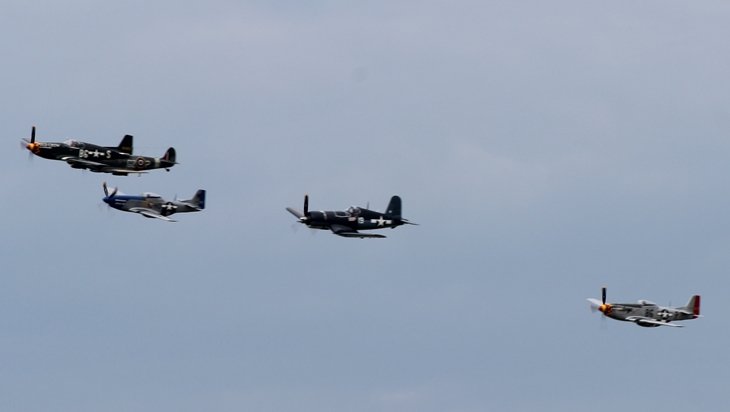
Here is a pass from right to left.
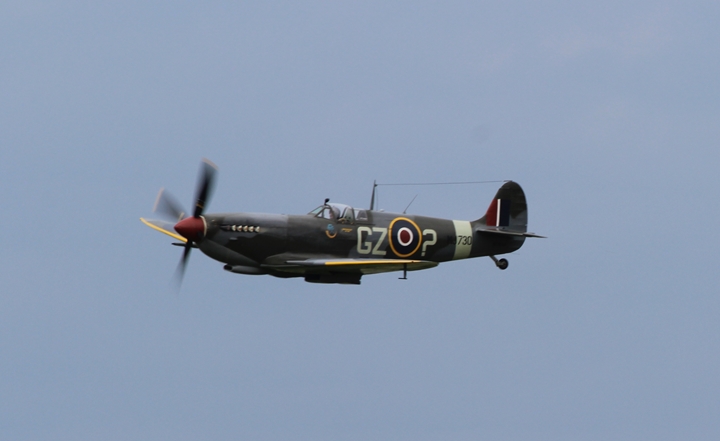
The Spitfire from Military Aviation Museum in Virginia Beach, VA.
When I was at Virginia Beach for the show in May this aircraft was being
worked on and did not fly, so it was a treat to see it fly at Thunder.
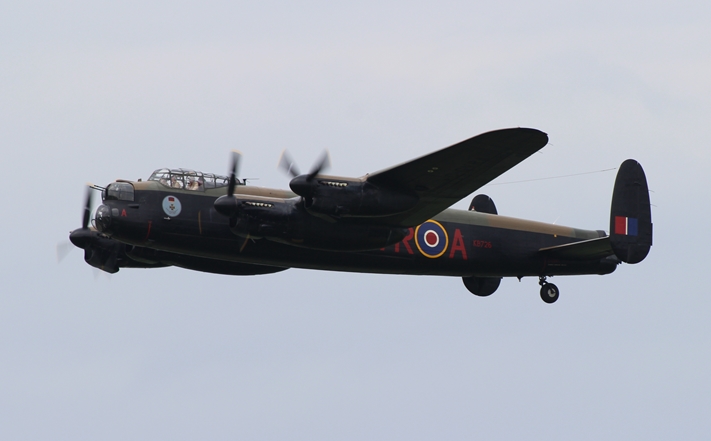
The bomber fly-bys with the diverse aircraft and diverse speeds made for
some really great fly-bys, such as this one by the Avro Lancaster.
US Auto Industry Contribution: Packard built engines and
propellers from Nash-Kelvinator in Lansing, MI.
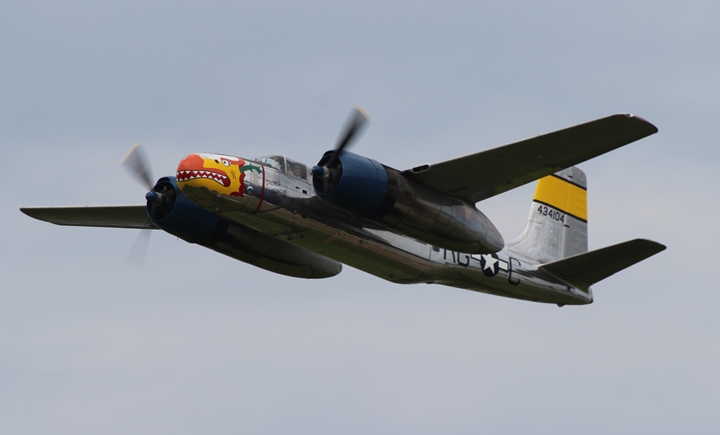
Douglas A-26 Invaders are rather rare at airshows and so it is great to
see this one, owned by Tim Savage and hangared about 60 miles from my
residence, fly for the first time. I hope to see more of the
"Silver Dragon" at airshows around the local area.
US Auto Industry Contribution: Ford not only supplied R-2800 engines for the PV-2 Harpoon
as noted above, but the
A-26, B-26 C-46, P-47 and P-61.
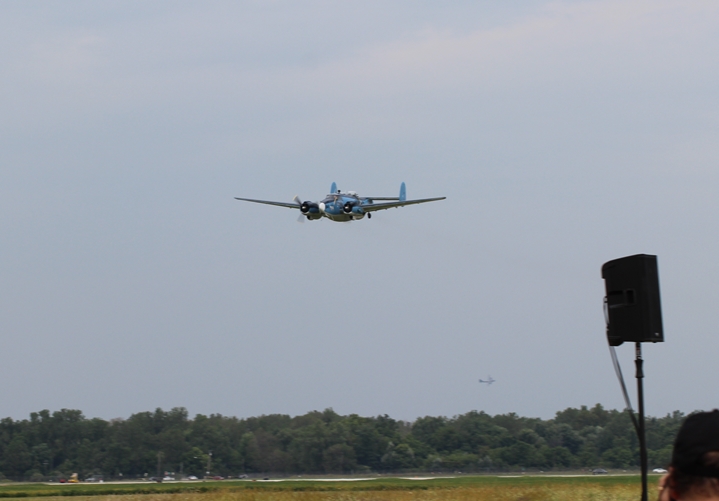
The Lockheed PV-2 Harpoon making one of many
low passes for the day with what looks like the B-29 turning base in the
background. At this time in the show the fast bombers were on a
racetrack pattern closest to the crowd with the slower bombers on the
outside track. The Harpoon has an unmistakable "whistle" to it as
it comes by.
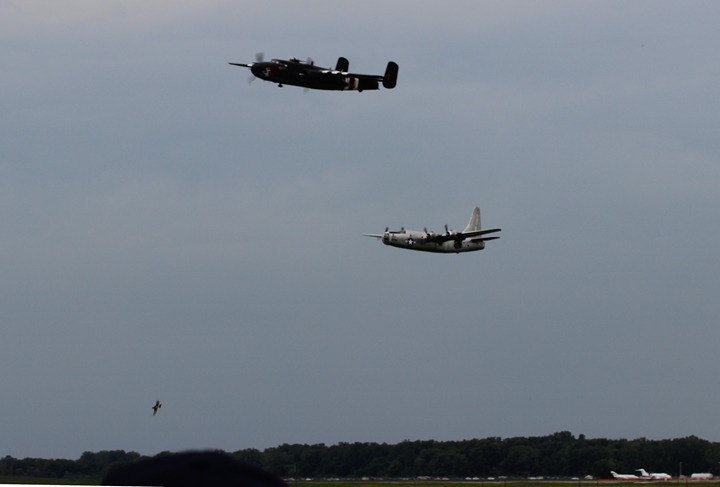
With the parallel tracks in front of the
crowd the spectator can have two aircraft out in front of him at the
same time. Here the B-25J "Hot Gen" from the Canadian Warplane
Heritage Museum as come from behind and passed the slower Privateer as
they pass in front of the crowd. A third aircraft is maneuvering
in the background.
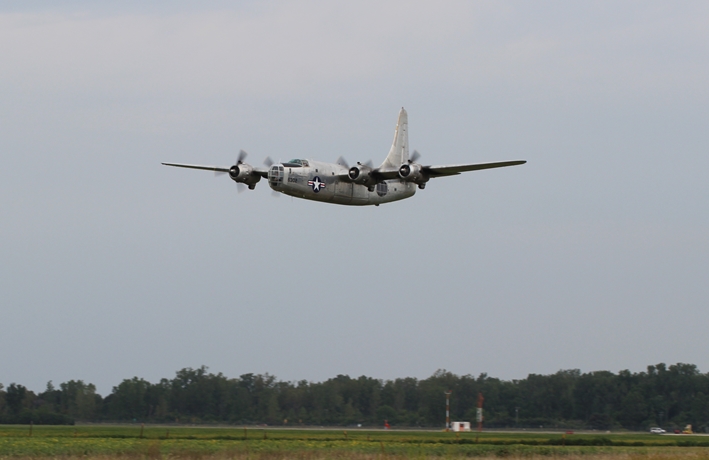
There the Privateer is on the inside track closest to the crowd.
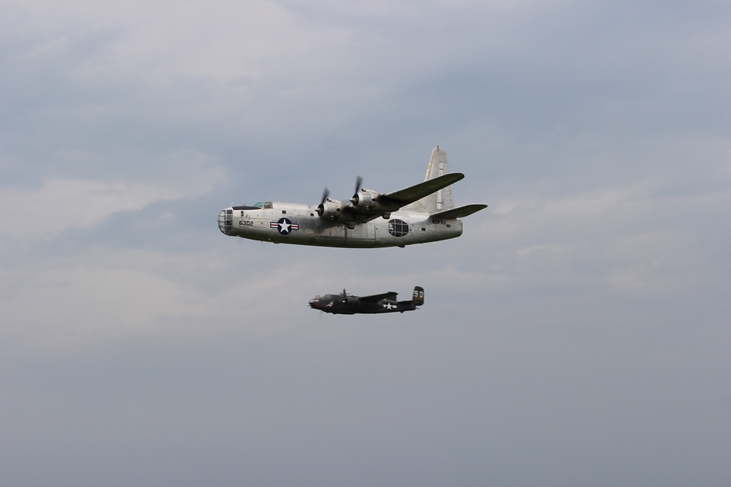
And here the Privateer is on the inside and the B-25 on the outside.
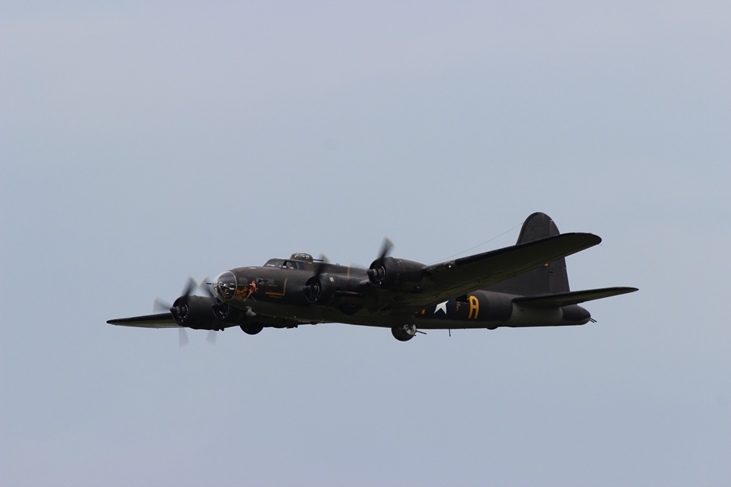
B-17 "Memphis Belle".
US Auto Industry Contribution: Studebaker built
R-1820 engines in South Bend, IN for the B-17 program while Chrysler
built cockpit enclosures for the Flying Fortress at its Los Angeles, CA
plant. Fisher Body Division of GM provided the exhaust manifolds.
Studebaker built 63,789
R-1820 engines for the B-17 and starting in January of 1944 all B-17s
produced came with Studebaker engines, such as the B-17G "Memphis Belle"
above had (Converted to look like a B-17F for the movie Memphis Belle.)
when it came off the Douglas assembly line in Long Beach, CA in April of
1944.
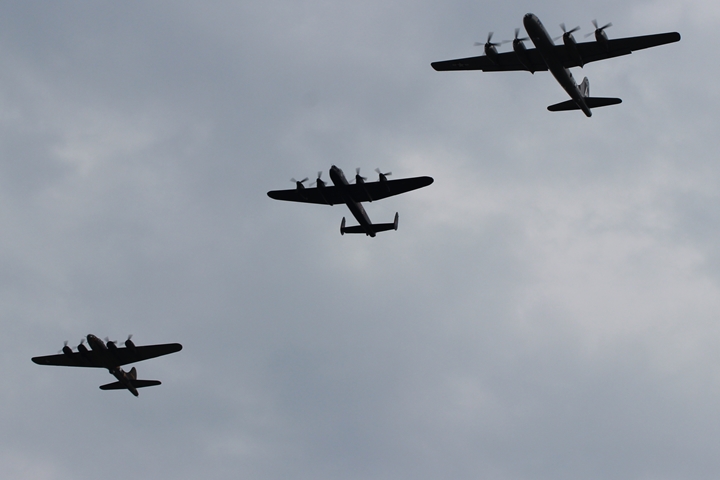
Another first! A "Missing Man"
formation flow with bombers, with an open slot for the "Missing Man".
This is the only time I have seen this done with bombers.
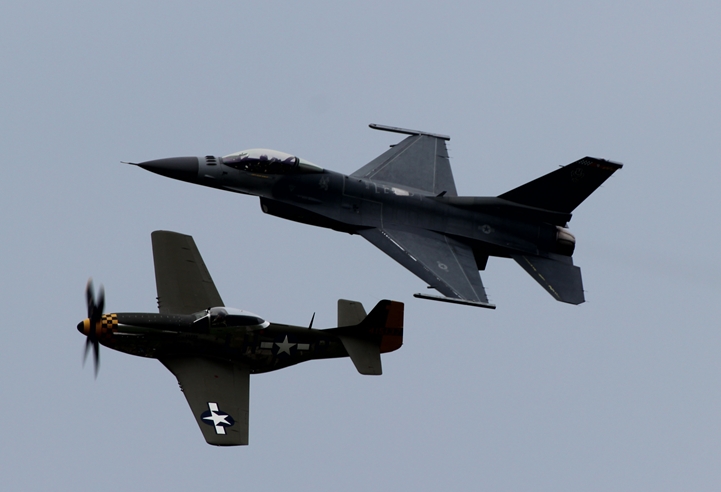
The sky kept getting grayer and grayer as the show progressed but here
is the USAF Heritage Flight as it passes in review.
Last, but not least is the B-29A Superfortess "Fifi", that was at the
show and flew some great low passes for the crowd as shown below.
"Fifi" is an "A" model as were all the B-29s that were built in the
Boeing plant in Renton, WA and, was designated as such because the wings
were attached to the fuselage with internal bracketing, which only left
room for three fuel cells of 1,120 gallons fuel tank, giving it a
shorter range than the B-29s built at Bell, Marietta, GA, Boeing;
Wichita, KS; and Martin at Omaha, NB. These aircraft were
designated as B-29 with no suffix and the wing passed through the
fuselage, allowing for four fuel cells totaling 1,333 gallons. Bell also built a
"B" model, which was the stripped down version with less armor plate and
only the tail gun position for self defense.
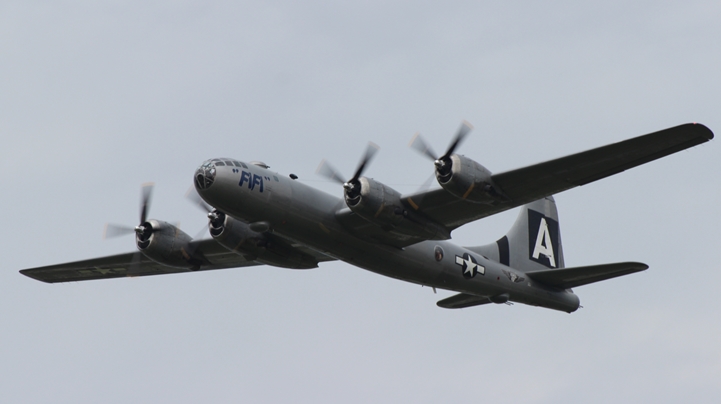
US Auto Industry Contribution: Very
significant and extremely important, and overlooked or ignored by
aviation historians.
Below is information provided to me courtesy
of Chris Howlett of the UK that he found researching the B-29 for his
new book, The B-29 Manual, which will be published by
Haynes this coming December. His information has been invaluable
in my research and shows which companies were the
major suppliers for the Superfortesses that were built by Martin in
Omaha, NB. Of significance is that Omaha built the Silverplate B-29s,
i.e. "The Enola Gay" and "Bockscar".
This only applies to the Omaha Plant, the
other information I have indicates some of the same parts shown below
were made by other auto companies and delivered to the other B-29
assembly plants.
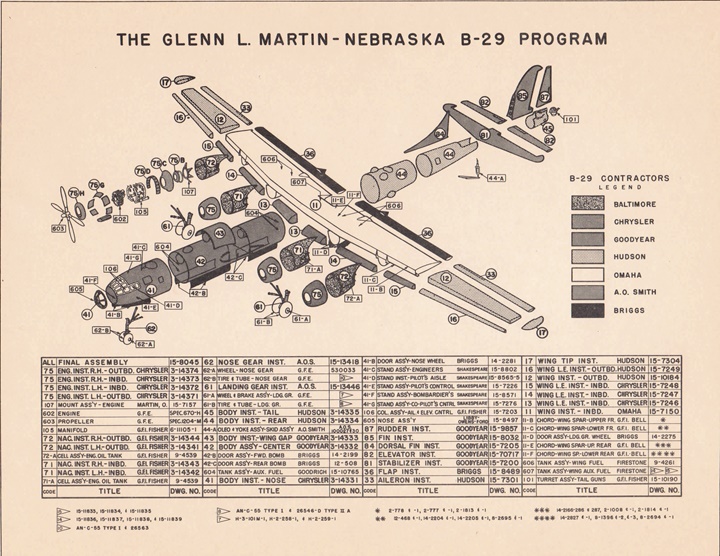

Starting at the front of the fuselage and
working towards the rear of the aircraft, the glass nose section was
built by Libby-Owens-Ford, an automotive glass company, while the
fuselage nose section was built by Chrysler's Plymouth Division in
Detroit. Goodyear in Akron, OH built the two bomb bay fuselage
sections while Briggs, an independent auto body manufacturer in Detroit,
provided the bomb bay doors. The three rear fuselage sections
behind the wings were also built in the city of Detroit by the Hudson
Motor Car Company, which combined in 1954 with Nash to become American
Motors. The entire tail section and the elevators with control
surfaces were made by Goodyear and the tail gunner's position was
manufactured by the Fisher Body Division of GM at Cleveland, OH.
In examining the wing, Martin Omaha provided
the center section while Chrysler provided the inboard leading edges and
Hudson built the outer wing sections, outer leading edges, ailerons and
wing tips and Briggs provided the flaps. All four engine nacelles
and engine oil tanks came from the Fisher Body Division of GM along with the
exhaust manifolds while Omaha built the engine mounts and Chrysler supplied
the engines and engine cowlings.
Firestone provided the main and auxiliary wing
fuel tanks and BF Goodrich the fuselage auxiliary fuel tank.
While this is a Boeing designed aircraft,
there are no major fuselage, wing or rear tail section components
provided by that company. With the exception of the Martin wing
center section, the rest of the wing was supplied by the American
automobile industry.
The next time you stop by Steven F. Udvar-Hazy
Center in Virginia and look at the "Enola Gay" or the National Museum of
the USAF in Ohio and see "Bockscar", remember even though it says Boeing
on it, the fuselage, control surfaces, most of the wing, fuel and oil
tanks and engines were provided courtesy of the American Automobile
Industry.
Titusville (Tico), FL
Virginia Beach, VA
Seymour Johnson AFB, NC
Halls, TN
Warsaw, IN
B-29 Air Power Tour Fort Wayne, IN
Thunder over Michigan, Bellevue MI
|





































